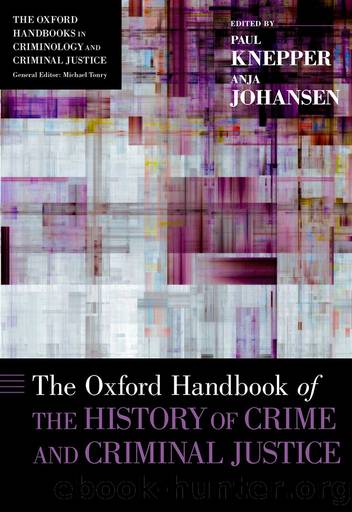The Oxford Handbook of the History of Crime and Criminal Justice (Oxford Handbooks) by Paul Knepper and Anja Johansen

Author:Paul Knepper and Anja Johansen
Language: eng
Format: azw3
Publisher: Oxford University Press
Published: 2016-04-15T00:00:00+00:00
I. READING CRIME FICTION AS HISTORY
Studies of crime fiction in Mexico, and, to a great extent, in Latin America, have focused on the renewal of the genre since the 1970s in the context of increasingly authoritarian political regimes. In Mexico, the bloody 1968 repression of a student movement in the capital signaled the extent to which the regime, in its quest to maintain political control, would deploy violence against and deny justice to citizens. The neopolicÃaco literature that emerged at this time exemplified the politically committed, conspiracy-centered tone and narrative resources that became the object of most of the scholarship thereafter. The tough detectives of those late novels were clearly modeled after those found in the U.S. hard-boiled novels of Chandler, Hammett, and others, leading scholars to deem earlier works, inspired by classics like Christie or Conan Doyle, as of lesser political interest (Stavans 1997; Braham 2004; Close 2008; Torres 2003; Jacovkis 2013, pp. 116â17). The writers who preceded the neopolicÃaco, emerging mostly in the 1940s, were pioneers perhaps, but little more in terms of literary accomplishments, dilettantes in contrast with the prestigious incursions into the genre by contemporaneous Argentine authors like Jorge Luis Borges (Jacovkis 2013, pp. 116â17; Monsiváis 1998). The first novel-length work in this genre, and probably the most accomplished, was Ensayo de un crimen, by Rodolfo Usigli. It was published in 1944 and ignored for decades, with its author achieving recognition only for his plays. The 1955 film by Luis Buñuel based on the book was more successful, although it did not meet with Usigliâs approval, focusing as it did on psychological themes that were closer to Buñuelâs surrealism.
Recent Mexican scholarship has nevertheless examined early crime fiction as more than a derivative exercise, a simple forerunner to the truly original neopolicÃaco. RodrÃguez Lozano, for example, proposes a strong continuity in Mexican production within the genre, from its beginnings until Rafael Bernalâs El complot mongol (1969) became the paradigm for subsequent noir production. The genre was always on the margins of the literary canon despite (or perhaps because of) its ability to attract numerous readers and critically refer to social life and politics (RodrÃguez Lozano 2008, pp. 5â6). Although he criticizes the imitative tendencies of the early stories, Torres documents the diverse origins of the genre in terms of themes, venues, and authorsâ national origins and influences, pointing to a variety of publications that in some cases left few traces for posterity (Torres 2003, pp. 23, 25, 26, 71). Author-centered notions of originality nevertheless continue to burden our contemporary readingâeven though, as in Japan, Mexican authors of the first half of the twentieth century did not see influence as marking inferiority: they inhabited a cosmopolitan trade in which similarities to U.S. or European authors were the product of a shared, globally modern present (Kawana 2008, p. 19).
Literary readings of the detective novel run the risk of neglecting the rich dialogue between narratives and life while stressing influence as the main form of intertextuality. Yet novels and short
Download
This site does not store any files on its server. We only index and link to content provided by other sites. Please contact the content providers to delete copyright contents if any and email us, we'll remove relevant links or contents immediately.
| Africa | Americas |
| Arctic & Antarctica | Asia |
| Australia & Oceania | Europe |
| Middle East | Russia |
| United States | World |
| Ancient Civilizations | Military |
| Historical Study & Educational Resources |
Magic and Divination in Early Islam by Emilie Savage-Smith;(1500)
Ambition and Desire: The Dangerous Life of Josephine Bonaparte by Kate Williams(1344)
Bohemians, Bootleggers, Flappers, and Swells: The Best of Early Vanity Fair by Bohemians Bootleggers Flappers & Swells- The Best of Early Vanity Fair (epub)(1343)
Papillon by Henry Charrière(1310)
Twelve Caesars by Mary Beard(1256)
Operation Vengeance: The Astonishing Aerial Ambush That Changed World War II by Dan Hampton(1135)
What Really Happened: The Death of Hitler by Robert J. Hutchinson(1128)
London in the Twentieth Century by Jerry White(1112)
Time of the Magicians by Wolfram Eilenberger(1089)
The Japanese by Christopher Harding(1086)
Twilight of the Gods by Ian W. Toll(1084)
Lenin: A Biography by Robert Service(1045)
The Devil You Know by Charles M. Blow(985)
A Social History of the Media by Peter Burke & Peter Burke(936)
Freemasons for Dummies by Hodapp Christopher;(922)
Napolean Hill Collection by Napoleon Hill(902)
Henry III by David Carpenter;(891)
The Churchill Complex by Ian Buruma(881)
The Rise and Triumph of the Modern Self by Unknown(879)
